We continue the section on how to choose the right smartphone that will delight the user. We have already talked: what are, what is better, the pros and cons. Today we will talk about choosing a smartphone screen. The topic is quite complex and extensive, since by now there are many technologies for the production of displays, their protection, in addition, they are presented in a variety of diagonals, with different ratios, and so on. It is the screen that often becomes a stumbling block when choosing a smartphone. It is not surprising. The display is exactly the part of the device with which we have to work more. In case of a wrong choice, there is a high probability that the screen will cause a lot of inconvenience: a poor-quality picture, low brightness, poor sensitivity. But do not worry, today we will touch on each of the aspects, telling you about all the intricacies of choosing a smartphone screen.
Smartphone matrix type
It is worth starting with the type of matrix. In many ways, the quality will depend on the choice of the type of screen matrix. So, today it is customary to distinguish three varieties:
- TN+film
- AMOLED
The first two are based on liquid crystals, the second - on organic light emitting diodes. Each of the types is represented by several subspecies (in the case of IPS, more than 20 different ones), which one way or another are found in the production of panels.
Some of you are wondering: "Where is the TFT?". Due to ignorance of some resources, this abbreviation is often used as a designation for the type of matrix, which is incorrect. The term TFT refers to thin film transistors used to organize the operation of subpixels. They are applied practically in each of considered types of matrices. Transistors are also available in several varieties, one of which is LTPS (polycrystalline silicon). LTPS is a relatively new subspecies, which stands out for its lower power consumption and more compact transistor sizes, which is also reflected in pixel sizes. As a result: a higher pixel density, a better and clearer picture.
TN+film

Back to matrices. Most of the matrices familiar to us, as already noted, are liquid crystal, that is, LCD. The principle is to polarize the light that passes through the filter, turning into the appropriate colors. The first of the varieties of liquid crystal matrices is TN + film. With the spread of "film" was dropped, shortening the name to "TN". The simplest type, which by today is rather outdated and is used only in the cheapest smartphones (and even then, you still have to find it). TN cannot boast of good viewing angles or contrast, and has poor color reproduction.
In general, avoid TN when choosing a smartphone screen - the type is outdated.
IPS

Next comes IPS. This technology is also not young - the age has already exceeded 20 years. Meanwhile, IPS-matrices are the most widespread in the smartphone market. Open any online store, choose the first smartphone that comes across and make sure of my words. This type of matrices is presented both in the budget segment and in the flagship one. In addition to improved performance, when compared with TN, IPS received a large number of varieties. However, you should not understand everything - two types of dominance are divided in the smartphone market: AH-IPS and PLS. Their creators are the two largest companies in South Korea and the whole world: LG and Samsung, respectively. What is the difference? She is practically non-existent. Matrices of two types are like twin brothers, so you can not be afraid to choose a smartphone with any of them. Identity has even been the subject of litigation between companies.
IPS boasts wider viewing angles than TN, good color reproduction, and a high pixel density, resulting in a gorgeous picture. But the power consumption is about the same - in any case, LEDs are used for illumination. Since there are quite a few varieties of IPS matrices, they also differ in their characteristics. This difference can be seen even "by eye". Cheaper IPS can be too faded, or vice versa - have an oversaturated color. It complicates the choice of a smartphone screen in that manufacturers are often silent about the type of matrix.
Definitely, when choosing between a TN and IPS screen, preference is given to the latter.
AMOLED
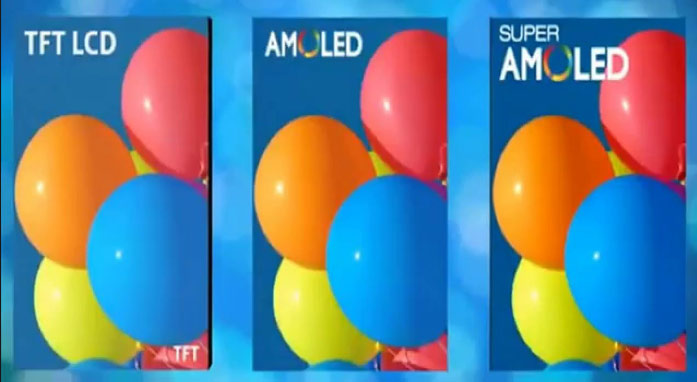
Even more modern type, which is common today, as a rule, among high-end smartphones. AMOLEDs are organic light-emitting diodes that do not require external illumination, as is the case with IPS or TN - they glow on their own. Already at this point, their first advantage can be distinguished - smaller sizes. Further - AMOLED is represented by more saturated colors. Black looks especially good, during the display of which the LED simply fades out. AMOLED displays are more contrasty, boast wide viewing angles and lower power consumption (there are nuances). Just a fairy tale, right? But before choosing a smartphone with AMOLED screen, you should learn about its shortcomings.
The main disadvantage is considered to be a shorter service life compared to IPS. After a certain period (as a rule, after three years changes in color are observed), on average, after 6-10 years, pixels begin to “burn out”. Moreover, bright colors are especially prone to fading, so users often use dark themes in order to extend the service life. In addition, power consumption is greatly affected by the brightness of the colors on the screen. If a bright picture is displayed in bright colors, then AMOLED consumes more energy than IPS. Finally, OLED arrays are more expensive to manufacture.
Be that as it may, this does not negate the manufacturability and quality of AMOLED. Sores in the form of "burn-in pixels" are gradually cured, and subspecies of matrices appear that are getting better. For example, Super AMOLED. This variety appeared seven years ago, bringing a lot of improvements. Power consumption has been reduced, brightness has been increased. In addition, the air gap between the tach and the matrix has disappeared, which increased the sensitivity of the screen, and also eliminated the ingress of dust.
AMOLED today is considered the most technological matrices that are actively developing. If until recently they were used mainly in Samsung smartphones, today they are chosen by a huge number of smartphone manufacturers (almost every major brand has presented a solution with an AMOLED screen.
Design features of smartphone screens
But not only the type of matrix should be taken into account when choosing a smartphone screen. There are still a whole bunch of features that affect the final quality of the picture and the feeling of using it. We will focus on the most important points.
Air gap

Until recently, the screens of all smartphones were represented by two components: the touch layer and the matrix itself. Between them there was an air gap, the thickness of which depended directly on the manufacturer. Naturally, the thinner the layer, the better. Companies regularly reduced the air gap, making the picture quality higher and viewing angles wider. Relatively recently, it was possible to completely get rid of the air gap thanks to OGS technology. Now the sensor layer and the matrix are merged together. Despite the significant improvement in quality, there is an obvious drawback. In case of damage to the OGG screen, it will have to be replaced completely, while in displays with an air layer, only the glass takes the blow.
Be that as it may, more and more manufacturers are choosing OGS screens. Yes, and we advise you to give preference to this technology. Believe me, you don't have to worry about the complicated repair of the feelings that you will experience when using such a display.

A relatively recent thread that Samsung brought to the market with its Galaxy flagship S6 Edge (was also Galaxy Note, but only one edge is bent there). The South Korean manufacturer will continue to develop the idea in subsequent smartphones, but the rest of the companies did not share the idea too much. The company bends the right and left sides of the devices - the screen seems to float on the ends. This is done not only for the sake of spectacular appearance but also for the convenience of the user. Are brought here additional functions, notifications can also be displayed here. A fascinating feature, but not everyone needs it.
Samsung managed to implement the curved display most successfully, therefore, if such a design is interesting, we advise you to consider the solutions of the South Korean brand.
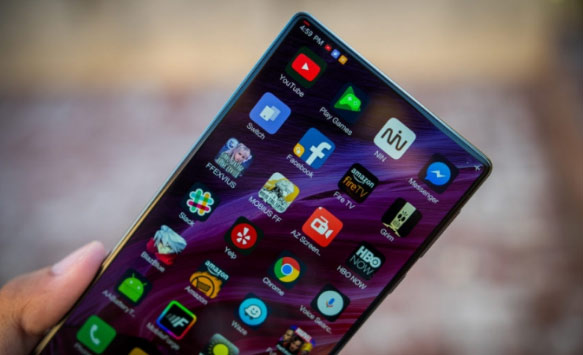
An even more recent trend is bezel-less screens. The progenitor is Sharp, which showed the first frameless smartphone back in 2014, but users were attracted by the frameless Mi Mix shown in 2016. By the summer of 2017, a number of companies announced their intention to release such gadgets. Today, the market is rapidly filling up, with the newest models costing less than $100.
To date, there are several variations of the bezel-less screen: elongated displays that have reduced bezels at the top and bottom; familiar displays, devoid of frames on three sides (except the bottom). The first type is samsung galaxy S8 is a pair of smartphones from LG (G6 and ). To the second -, Doogee Mix, Xiaomi Mi Mix and many others, whose ranks are constantly replenished.
Frameless smartphones look really cool, and the low cost allows everyone to try out modern technologies.

The well-known company Apple in the iPhone 6S introduced new technology at the time of release - 3D Touch. With it, the screen began to respond not only to touch, but also to the force of pressing. The technology began to be used, as a rule, to commit any quick action. Also, 3D Touch made it possible to work with text, draw with great comfort (the brush reacts to the force of pressure), and so on. The function did not become something completely unusual, but it found its user. Later, a similar technology appeared 6, was also announced in .
Touch screen type
Not a particularly important criterion when choosing a smartphone screen, but, nevertheless, let's dwell on it a little. There are several types touch displays: matrix (very, very rare) resistive and capacitive. Resistive screens were ubiquitous until recently, but today they are only found in very rare and cheap smartphones. This type is different in that it reacts to any touch: with a finger, a pen, or at least control another phone. It supports only one touch, it does not always work accurately. In general, an obsolete type.
Capacitive screens are vastly superior to their predecessors. They already support more than one simultaneous touch, have better sensitivity, work much more accurately. However, their production is more expensive.
Like it or not, the vast majority of companies have abandoned resistive screens in smartphones. And this is for the best. In addition, the cost of capacitives is constantly decreasing, which allows manufacturers to install them in the cheapest smartphones.

Another important aspect when choosing a smartphone screen is the number of simultaneous touches. This parameter determines what operations you can perform on the display. The first smartphones equipped with resistive screens, were limited to one simultaneous touch, which was not always enough. Screens modern smartphones often support 2, 3, 5 or 10 simultaneous touches. What gives big number simultaneous touches:
- Scaling and zooming. One of the first features that appeared in the iPhone - the first smartphone with support for two simultaneous touches. For example, you can reduce or enlarge images by pinching or spreading your fingers on the screen.
- Gesture control. Multiple fingers make it possible to use various gestures.
- Management in games. Most modern games require the use of several fingers at the same time.
Do not chase support for 10 simultaneous touches if you do not play on a smartphone. For the vast majority of users, 5 touches are enough, and even less demanding ones will not experience discomfort with 2.
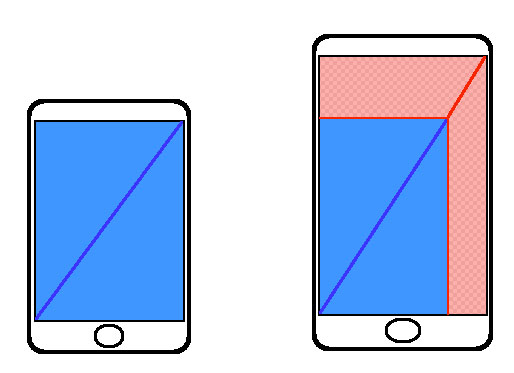
Significant parameters when choosing a smartphone screen go hand in hand. The diagonal of the display reflects its dimensions in inches.
An inch corresponds to 2.54 centimeters. For example, the screen diagonal of a 5-inch smartphone in centimeters is 12.7 centimeters. note: Diagonal is measured from corner to corner of the screen, excluding bezels.
What screen size to choose? You will have to answer this question yourself. The market of modern smartphones offers a variety of diagonals, starting from about 3.5-4 inches, ending with almost 7 inches. There are also more compact options, but you can ignore them - working with miniature icons is not very convenient. The best way choose a diagonal - personally hold the smartphone in your hands. If you are comfortable using one hand, then the diagonal is “your”.
It is also impossible to recommend specific numbers because each person has a different hand size, finger length. One and 6-inch is comfortable to use, the other - and 5 inches is a lot. It is also worth considering that smartphones with the same diagonal can be of different sizes in general. A simple example: a 5.5" is comparable to a 5" model with regular bezels. Therefore, when choosing a smartphone screen, it is also desirable to take into account the thickness of the frames.
Be that as it may, there is a tendency to increase the diagonals of the screen. If in 2011 the vast majority of users were limited to 4 inches, then in 2014 the largest percentage belonged to 5 inches, today the market is captured by solutions with 5.5 inches.
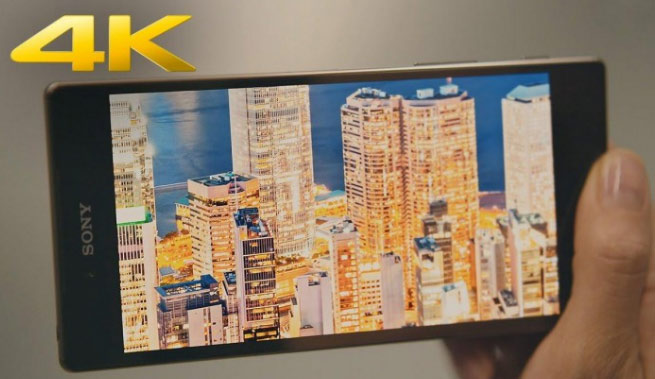
With permission, the situation is simpler.
Resolution reflects the number of pixels per unit area. The higher the resolution, the better the picture quality. Again, the same resolution looks different on two different diagonals. Here it is worth mentioning the density of pixels per inch, which is denoted by the abbreviation PPI. Here the same rule as in the case of resolution: the higher the density, the better. True, experts do not agree on the exact figure: a number claims that a comfortable value starts at 350 PPI, others give large numbers, and others give smaller ones. At the same time, it is worth remembering that human vision is very individual: someone will not see a pixel even at 300 PPI, while the other will find something to complain about even at 500 PPI.
- with a diagonal of up to 4-4.5 inches, most smartphones get a resolution of 840x480 pixels (about 250 PPI);
- 4.5 to 5 inches good choice is HD-resolution (1280x720 pixels) (density ranges from 326 to 294 PPI)
- more than 5 inches - you should look towards FullHD (1920x1080 pixels) or even higher resolutions
Latest Samsung smartphones and a number of models from other companies receive a resolution of 2560 × 1440 pixels, which provides a high pixel density and a clear picture. The recent flagship from Sony was even presented with a 4K screen resolution, which at 5.5 inches guarantees a record 801 PPI.
Screen coverage
Until recently, the screens of mobile devices were covered with ordinary plastic, which quickly scratched, distorted the color rendition, and did not feel very tactile. It was replaced by glass, which does not care about the keys lying around in your pocket. Now on the market there is not a single type of glass that differs in strength and, accordingly, in price. 2.5D glass, curved from the edges, has gained particular popularity today. They not only guarantee high reliability, but also give the smartphone a more stylish look.
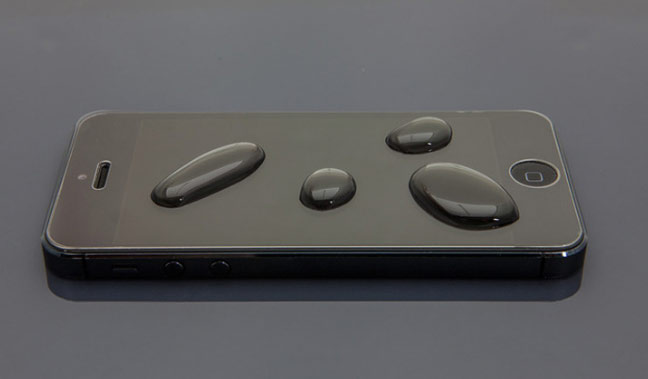
In addition, the screens of modern smartphones have a special oil-repellent coating (oleophobic layer), which provides good finger gliding and prevents stains. To determine the presence of an oleophobic layer, it is enough to place a drop of water on the screen. The better the drop retains its shape (does not spread), the better the layer.
Naturally, the quality of the oleophobic layer and glass affect the cost of the smartphone. You will hardly find a budget model that can boast the same durable glass as the flagship solution. Today, the most popular manufacturer of protective glasses is Corning, whose line ends with Gorilla Glass 5.
Additional screen

If one display is not enough for you, then a number of companies offer smartphones with additional screens. They are usually small, but serve to display notifications. And YotaPhone 2, known to many, offers a second E-link display that occupies the entire back side, which is convenient to read. AT model range LG has solutions with a small screen that displays notifications. Recently, a similar smartphone with additional screen Meizu was also noted with its flagship.
The second screen is a rather peculiar feature that not everyone needs. Nevertheless, such smartphones find their user, and more than one.
Conclusion
Well, they seem to have told about all the intricacies of choosing a smartphone screen. The material turned out to be quite extensive, we hope that everyone will find answers to their questions. You should not chase the most expensive screen, but it is also contraindicated to save too much - we are looking for that very golden mean. Although the current mobile electronics market itself will direct you in the right direction, pointing out what is popular and in demand. Today, the risk of stumbling upon a low-quality display that will be dull when pressed is much lower, manufacturers have significantly raised the quality bar. Even third-tier companies use quite solid matrices in their ultra-budget smartphones. Well, we can only wish you good luck in your choice.
By the way, the line of articles on the criteria for the right choice does not end there. We have already talked about that, check it out. Materials on the topic of choosing a processor and cameras will appear soon, so subscribe to notifications and the Vkontakte group.
The smartphone may have powerful stuffing and take excellent pictures, but the user will still not be completely satisfied with them if the screen quality leaves much to be desired. Unfortunately, in terms of display performance, many buyers are complete laymen. Therefore, it is so important to consider what types of smartphone displays are found and what parameters you need to pay attention to when choosing a gadget.
Previously all displays touch phones classified into:
- capacitive. The principle of operation is as follows: the user's finger transfers the charge, and the device software calculates in which area of the screen the change occurred.
- Resistive. Behind the screen are two metal plates. When the first is pressed against the second, the smartphone reacts. Smartphones with resistive screens often came with styluses.
The use of resistive displays was inconvenient, since you had to apply force when pressing. Resistive displays finally disappeared from shop windows in 2011, and the last “swallow” was the model Samsung S5230 star , once very popular among the fair sex.
Common Display Technologies
There are such types of displays:
TFT
Screens made using this technology are mounted in budget gadgets. Image quality can be very decent, but some imperfections will still be noticeable (such as minimal viewing angles). The peculiarity of TFT displays is that they are not capable of producing perfect black - only dark gray.
IPS
advanced TFT technology, which guarantees high contrast, rich colors (in particular, black and white), large viewing angles. Recently, IPS phone displays have become more and more common - even Chinese sellers are abandoning TFT technology.
AMOLED
Matrix consisting of organic light-emitting diodes. This technology not only provides brighter colors than IPS, but also allows the smartphone to work longer in offline, because the black color is formed by turning off part of the LEDs. AMOLED displays are usually found on Samsungs, which is not surprising, because it was the Korean company that developed them.
SuperAMOLED
Later improved the device AMOLED displays, removing the air gap between the screen and the touch layer. Due to this, image detail, color saturation have increased, and the display itself has become thinner. Curiously, Super AMOLED screens have been nicknamed "acid" by the people because of their excessive brightness.
SuperLCD
Such screens are rare on smartphones - one of the gadgets with a similar display was One X. SLCD technology provides warm and rich colors, but puts the smartphone down faster than AMOLED and IPS.
What gives screen resolution?
Any screen consists of a huge number of "squares" - pixels that fit snugly together. Each of the pixels in turn consists of 3 subpixels (subpixels): red (R), green (G), blue (B). As nutrition is received, they mix in different proportions and give some color. You can calculate the number of pixels on a device screen by multiplying two display resolution parameters: height and width. For example, an HD display ( 1280 * 720 ) comprises 921600 pixels. That is, the higher the resolution, the clearer the picture will be. On gadgets with a minimum resolution, the “squares” will be visible to the naked eye.
There is another indicator - DPI, which reflects the density of dots per inch of the screen. When choosing a gadget, the DPI indicator should be given even more attention than the resolution, because the screen sizes of smartphones are different. Note that a person with excellent eyesight and ideal conditions capable of distinguishing density up to a maximum of 350 DPI. In real conditions, 250 DPI is enough. This means that for a smartphone with a diagonal of 4.5-5 inches, an HD display abounds. Buying a gadget with more "cool" display characteristics will only lead to negative consequences: firstly, the buyer will overpay, and secondly, the smartphone will run out faster.
What are the best screen sizes?
Visionary Apple Steve Jobs determined that the most suitable screen size for a smartphone is 3.5 inches; that's exactly what they had popular models 4 and 4S. With a diagonal of 3.5 inches, the average user can reach the thumb of the hand (which holds the gadget) even to the farthest point of the display.
However, you can now find a smartphone with such a diagonal only in a showcase with budget models. The trend of increasing display sizes continues to gain momentum - large companies are already releasing smartphone-class devices with screens as large as 6 inches! For comfortable work, 4.7-5 inches is enough - such a gadget can still be controlled with one hand. A larger smartphone will cause inconvenience both in use and when stored in your pocket.
Conclusion
When choosing a smartphone, you need to remember that chasing outstanding display characteristics is pointless - the owner of a device with a 4K screen resolution will not receive any visible advantages. On the contrary, the user will be doomed to the constant wearing of the memory, since the duration battery life smartphone directly depends on the display settings.
The screens in modern mobile phones are amazing and pleasing to the eye: sometimes it even seems that the colors on the screen look more realistic than in real life! Nowadays, the quality and type of display can be a decisive factor when choosing a mobile phone, so we decided to talk about the different types of screens used in modern mobile smartphones and phones, or rather about their advantages and disadvantages.
Everyone is familiar with such terms as "AMOLED", "Super AMOLED" and even "Retina display", which, recall, is used in Apple iPhone 4. But few people know that, for example, "Retina display" is just a TFT screen with extremely high resolution, a Super AMOLED differs from a conventional AMOLED screen not only in a twenty percent increase in brightness, but also in a significant reduction in the thickness of the screen itself, as well as its power consumption.
In this article, we will talk about these and other interesting facts. But first, a little theory.
STRUCTURE OF MOBILE PHONE DISPLAYS
Liquid crystal TFT screens consist of two polarizing filters (vertical and horizontal); between these filters are electrodes, which in turn contact directly with liquid crystals. The color filter is responsible for the color of a pixel. When a voltage is applied, the LCD molecules change shape, which allows you to influence the transmission (or non-transmission) of light, that is, to form the color of the pixel. An indispensable attribute of TFT screens is the light source, or rather, the backlight of the display. Light, passing through the structure described above, just takes on the required color (color).
OLED screens are based on organic light emitting diodes. When an electric current is passed, the diodes emit light of a given color. This is what determines the main difference between OLED displays and TFT ones: "diode" screens do not need "background" display illumination, without which no TFT screen of a mobile phone will work.
RETINA DISPLAY: DISCOVER
Translated from English, the word "retina" means "retina". This name of the display (or rather, such a marketing ploy by Apple to promote the Apple iPhone 4) is based on the assertion that the human retina can process maximum amount 300 dpi image details at a distance of 30 centimeters. According to Apple, making higher resolution screens is unreasonable and irrational, although some experts assure us that the human eye from the same distance is able to recognize and process information from a 470 dpi display.
Be that as it may, the Retina display in the Apple iPhone 4 has a high resolution (with an incredibly small pixel size: only 78 micrometers), as well as amazing viewing angles, since it is actually made using IPS technology. Nevertheless, Retina display is still a TFT-type screen with all the disadvantages and disadvantages that follow from this.
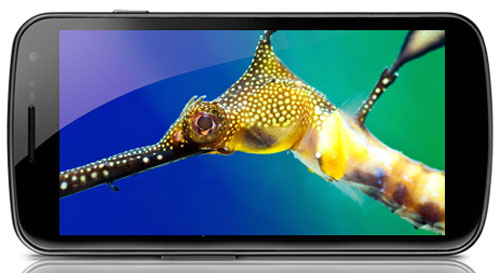
TFT VS AMOLED
TFT touch screens, roughly speaking, consist of 4 layers: a protective glass, a touch panel, the screen itself and a backlight. OLED displays, as we have already found out, do not need a backlight, and therefore consist of 3 layers: glass, touch panel and screen.
What gives us, users, this difference? Firstly, of course, a shorter response time (especially when it comes to AMOLED displays, that is, active matrix OLEDs). Secondly, OLED screens traditionally have higher brightness and contrast, although IPS TFT displays can be compared to AMOLED screens in these indicators. But it is unmistakable to distinguish TFT display from OLED allows black color: it is impossible to achieve a truly black color in TFT-screens, due to their obligatory backlighting. But in OLED displays, as they say, “black is black”.
ADVANTAGES OF SUPER AMOLED
The main achievement of Super AMOLED technology is that it allows you to remove another extra layer from the AMOLED screen. Touchpad no longer needed, it is integrated into the display itself, located under protective glass. Naturally, this allows you to reduce the thickness of the screen (by about 40% compared to AMOLED displays and almost twice as compared to TFT matrices). What's more, the two-element circuit provides better light transmission, best color rendering and higher brightness Super AMOLED displays compared to AMOLED screens (not to mention TFT displays, even if they are based on IPS technology). The last but not least advantage of Super AMOLED is the behavior of this type of screens in the sun: according to independent experts, this technology allows you to increase the amount of perceived information by 20% with direct sunlight on the screen.
To date, there are several different technologies for the manufacture of phone screens and between them there is an unspoken struggle for superiority.
Such a fate did not pass and ips along with amoled.
IPS and AMOLED - what it is?
When buying a telephone, not everyone pays attention to its important part - the screen. The main thing is that he was. And he worked well.
Not even all users know that they are different and differ from each other in a number of characteristics.
But still screenips oramoled- what's better?
In the IT technology market, there are several methods for the production of telephone screens:
- Amoled - Used by Motorola, Samsung, HTC and LG.
- TFT - Siemens, Samsung.
- E-Ink - Digma, Sony, Tesla.
- LCD - are more common among all presented. Nokia, Samsung.
- Ips - Lenovo, Xiaomi.
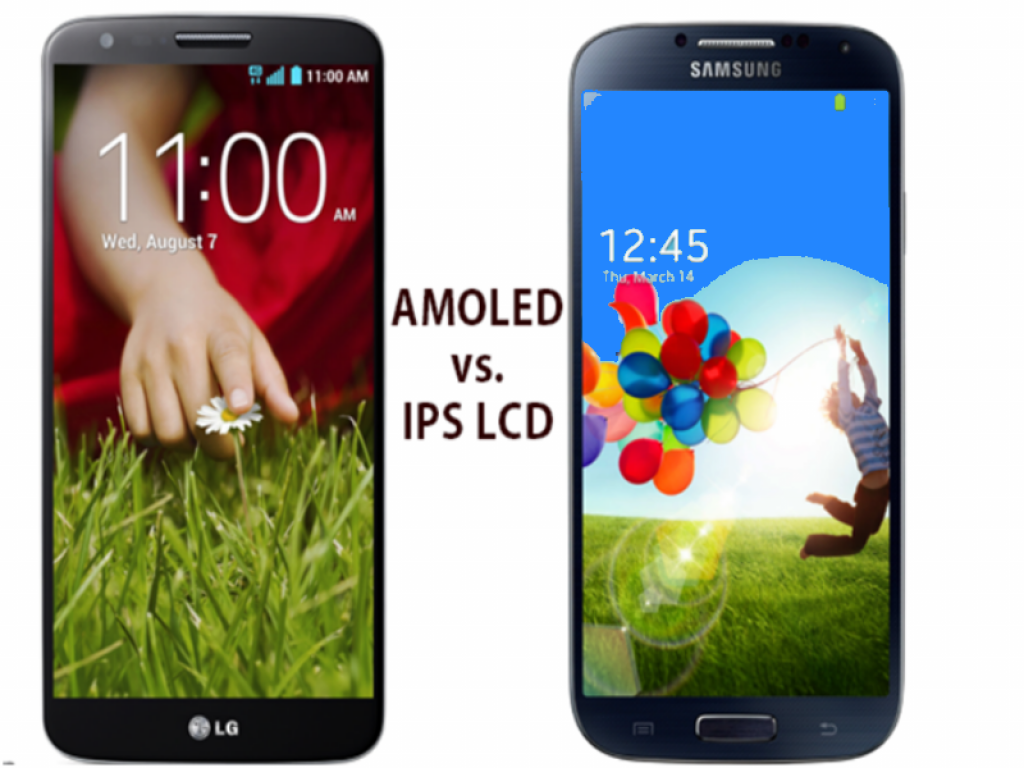

A moled
Display technology inspired by LCD screens . They convey a fairly rich range of colors, for which they differ from all the others.
The image is bright and saturated. At first, such a color rendition indescribably pleases consumers, but over time, people begin to notice that their eyes get tired of it.
Such displays appeared for the first time in 2009 and were used by Samsung. During the first year, this technique was introduced into production by about fifty more manufacturers.

Ips
ips - appeared in 1996 and over the entire period of its existence have been transformed and improved their specifications. Copyright belongs to Hitachi and NEC.
Transmits fairly natural colors. This is achieved by the fact that crystals with this technology do not turn into a spiral, but perform a turn together when applying an electric field.
Won the recognition of consumers and is widely used by manufacturers in the manufacture mobile phones.
What is the difference between the screens?
Many users now understand mobile phone screen formats and choose a device based on these characteristics. And more and more people are wondering ips or amoled?
The difference between them is not obvious to everyone. After all, both options are good, but regarding what the consumer requires from them, one can name the advantages and disadvantages of each of them.
Phone display made in use IPS technology requires a backlight for the screen, which consumes a lot of battery power.
The difference with amoled technology is that such phones do not need a backlight at all.. The next point, if we compare, it is much thinner.
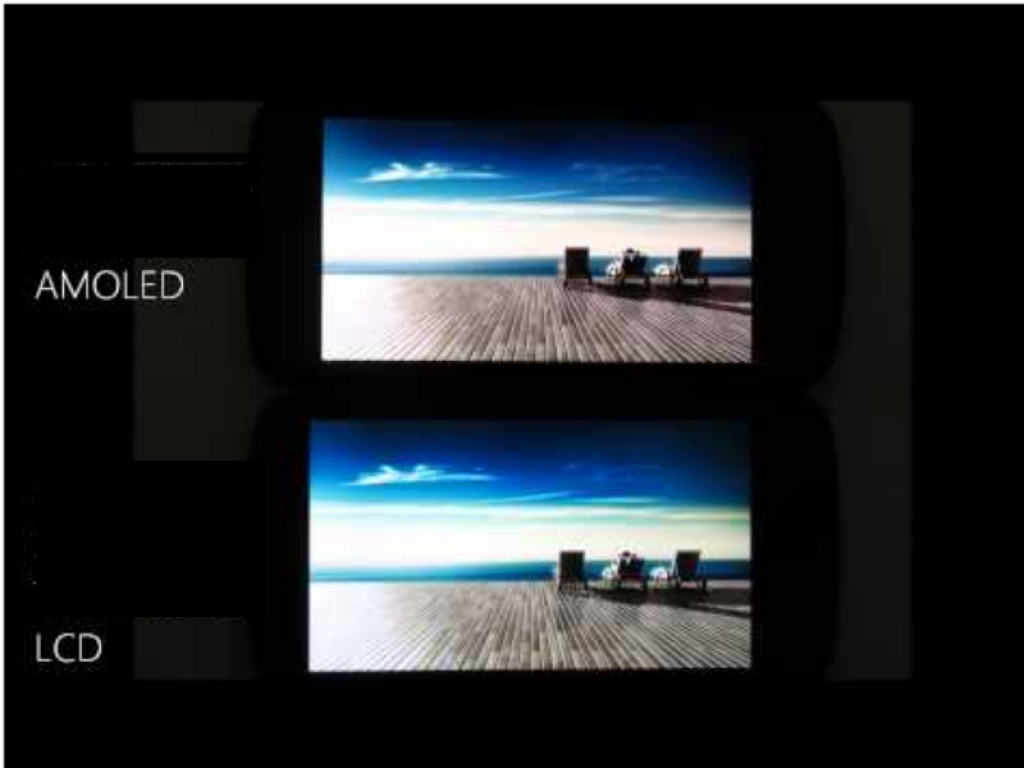
Referring to the figure, it can be seen that in the first variant top corners darkened to a greater extent, that is, the viewing angle is smaller.
Also, when visually studying both models, you can see that in the second picture the picture is a little brighter.
Still, the lights on the screens are different, and this is clearly visible to the naked eye.
If you express your own opinion about both models, then both drawings are good in their own way.
And after buying any of the models, the owner of the device will not even notice that there is any difference. It's just that each of the topics is presented in its own way.
After some time, Samsung tried to improve amoled displays and developed a new product - this technology was called super amoled.
Now let's figure out what took the lead among buyers - ips or super amoled?
In super amoled displays, manufacturers tried to eliminate some of the negative qualities of the technology and came to the conclusion that they eliminated one layer in the screen, and therefore removed one layer of air.
The main task of the new development was to get rid of the phone's screen glare while using it in the sun.
Method, from previous version differs only in that the number of subpixels has changed. And, as you know, the more of them, the better the color rendition occurs.
This is due to the fact that light conducts in more and the output image is very clear and bright.
Both models, as a result of the comparison, can boast of their positive aspects. As well as show their own shortcomings.
Positive qualities Ips
1 On its screen, the picture appears beautiful, bright and clear - real, without a technically invented design of the gamut of colors. Matrices made using amoled technology cannot convey such a natural picture. That is, if the photo turned out to be successful and all colors are captured and transferred correctly, then this is how it will appear on the screen.
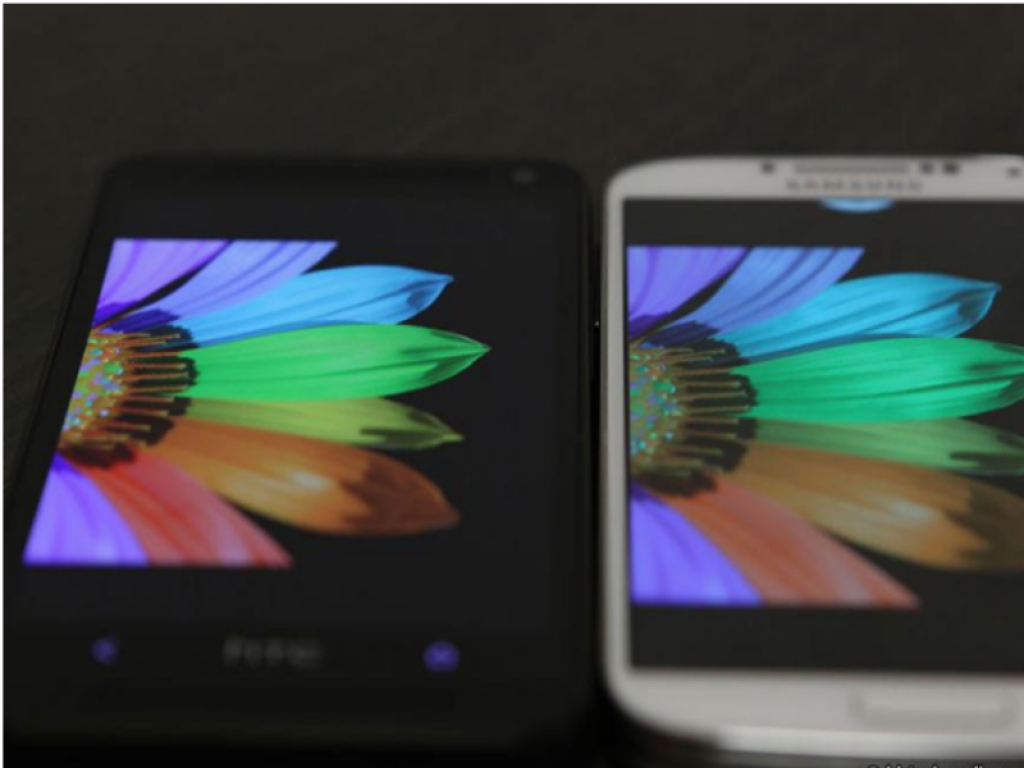
2 On amoled, you can get a natural color only by performing various manipulations in the settings. So, the manufacturer has developed a special database of configurations that are responsible for setting the correct color reproduction.
If such settings are present on your device, then both models made using the technologies in question will be almost equal in rights and will not differ from each other.
3 In amodet phones it is absolutely impossible to set up the transmission of white color in a qualitative way. But Ips displays exactly this, without any distortions and changes. What I received when photographing, I sent it to the display. For some users, this anomaly does not interfere at all. But there are other problems with colors.
When the same white is reproduced, a variety of pinks, blues, or yellows appear on the monitor.
Manufacturers have not yet been able to remove this defect. Only it was decided to fix the problem with individual settings.
Solving the problem described in the first option is not difficult, but as for the rest of the output gamma presented in option number two, it is much more difficult to achieve the desired result.
If the user has such a phone for the first time, then he will spend a lot of time before something changes.
4 Another advantage of Ips is that the pattern remains the same no matter what viewing angle you view it from. There is no degradation. For example, if many people want to see on one screen, then they will have absolutely no difficulty with this. Under all tilt angles, the picture will be the same.

5 In amoled screens, a shift in the color gamut to cold shades is often seen. In addition, due to the interesting distribution of sub-pixels, green and red tones are clearly visible when viewed from different angles.
6 Amoled screen burns out over time and this is its next disadvantage when compared with Ips. Because in the latest phone such problems simply do not exist.
7 Ips is considered better because the sharpness of the screen and its detail is much better. In AMOLED display, some of the users can see the pixels in the picture. Such a defect is noticeable even to the naked eye, without comparison with any other model.
8 The last advantage, but important enough for consumers, is the price policy. Ips is much cheaper than the other option, but at the same time, it has a lot of qualities that make you think when choosing a model to buy.
Positive qualities Amoled
This is not to say that amoled displays are so bad, as it turned out to be shown in the first comparison. These phones certainly have their positive qualities, consider them.
1 The screen, if a comparative analysis is carried out, is noticeably thinner. Although not a very weighty argument, some users may appreciate it.

2 It is believed that the display of the model in question is more economical. It turns out that each individual subpixel glows independently.
3 However, the issue can be called disputable, because when using light backgrounds, the energy consumption is stronger, on dark colors - less. That is, if a person uses a light screen more often, the charge does not last long, and if it is black, then vice versa.
4 Contrast is considered to be an undoubted advantage in Amoled. There are no similar analogues in the world yet. This is very attractive to a person who has not yet used a phone that shows such vivid images. After some time, the euphoria passes and only eye fatigue remains, but this is later.
5 Display on mobile device responds to responses faster. So, we can expect that the pictures on the screen will change faster.
6 Just like Ips, it has a completely dark display. This effect is obtained due to the fact that, if necessary, not all subpixels are highlighted, but only those that are on this moment necessary.
User opinion about phone screens
Summing up the listed advantages of each of the phones, it's hard to say which one is better.
One thing is clear amoled or ips- which is better, everyone should make a choice individually.
After all, some people are chasing a wide screen, others for the speed of the device, the next important thing is its size.
All these and many other characteristics, to some extent, are present in each of them.
Of course, judging by what is written above, ips has a little more advantages and is better made, but this does not mean at all that the other option is not worth your attention.
You can see that the technological characteristics of the latter have a slight overkill in the supply of colors. This, by the way, slightly affects the eyes.

Also, you need to be prepared for the fact that one hundred of its service life is less than what the manufacturers claim.
After all, most often, before using the device for a year, a person begins to notice that the screen is slowly burning out.
Unfortunately, but for some time this will lead to its complete unusable state.
About ips, we can say that in terms of the transmission of colors, it surpasses the naturalness of the resulting image. And their service life is a little longer.
Of course, it is impossible to foresee all the nuances and do without drawbacks. Such a fate did not pass and the models we are considering.
Ips Disadvantages
- One of the points for which a phone can be given a negative rating is the thickness of its screen. It is slightly larger and the reason for this is the backlight, which is built into the middle.
- The backlight for such a model is required much more powerful, and because of this, it turns out that energy consumption is also more.
- The matrix produces its response to actions a little slower. This fact is almost not noticeable, but still, there is a place to be.
![]()
Disadvantages of Amoled
- The production technology of such a model, in comparison with Ips, is more expensive, and at the same time even more difficult.
- After a short time, the colors begin to fade and the screen becomes unusable.

Comparison super amoled andips
After the manufacturer saw its obvious shortcomings, it tried to correct them as soon as possible.
As a result, an updated technology called super was born. amoled. So, super amoled or ips what's better?
Recently, Samsung has been using a production technology for displays called super amoled in almost all of its models.
It is quite different from the manufacture of a liquid crystal screen.
The main difference is that there is an air cushion that is located between the touch screen and the rest of the phone.
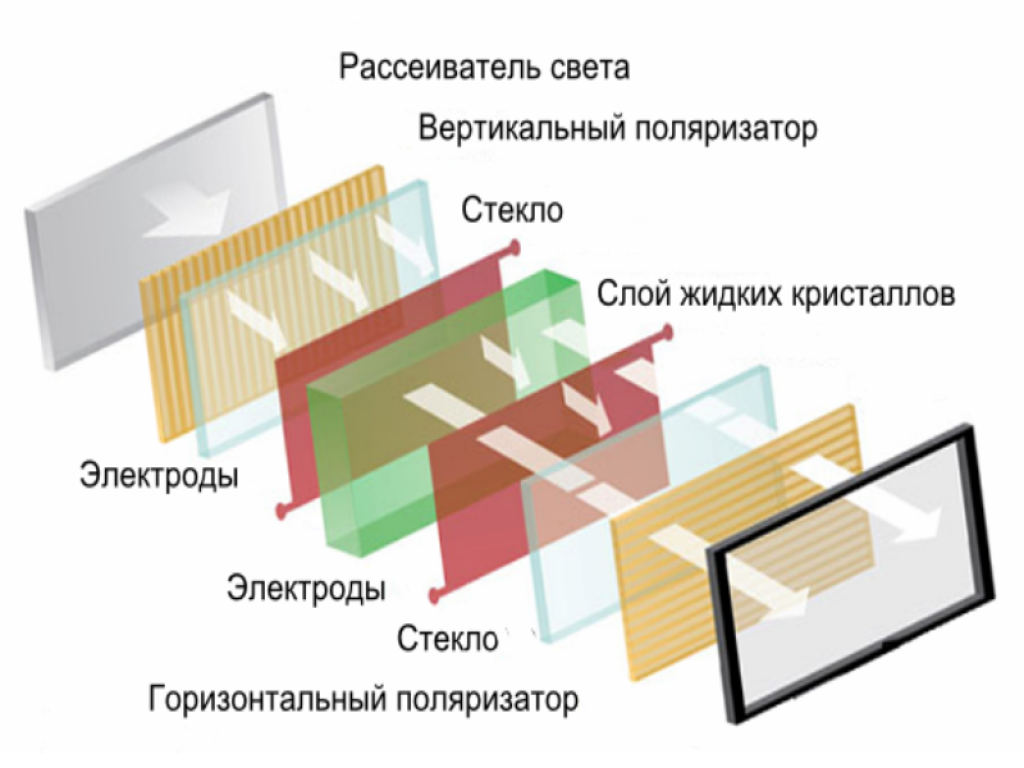
Layer touch screen in such models is located directly on the matrix. Thanks to this move, a reduction in the power consumption of the device was achieved.
Also, dust cannot get under the cover by any of the images. And yet, the glare disappeared in the phone.
Screens made using super amoled technology are completely different from liquid crystal screens made using the ips method.
So, if the displays of the latter consist of a group of crystals, a substrate, a mirror type and a diode backlight, amoled screens use LEDs instead of such particles. They just have multi-colored filters.
And so, let's list the advantages of both options and try to decide which is better.
super amoled
This screen is made even thinner than its predecessor. This was achieved due to the fact that they removed one layer - the air cushion.
This decision affected the transmission of the brightness of the display. It has increased by twenty percent.
Energy consumption is quite economical, it practically did not succumb to any changes.
Manufacturers promise that phones will be readable when in places where it is impossible to hide from direct sunlight.
Having tested this argument in sunny territory, one can object to such a theory a bit and say that visibility continues to limp.
Yes, in comparison I ips, the picture looks better. But this is not the result that the average person would like to see.
Positive qualities of super amoled display:
- The screen will last a very long time, according to the developers.
- The viewing angle is huge.
- There is a muting of glare at the time of exposure to the rays of the sun.
- The brightness is greater than in all of the above options.
- The color options are very saturated and the shades are very diverse.
- The picture that the phone gives out is much worse than the first one. And even less bright.
- The device is very vulnerable to all sorts of mechanical damage, which makes it not so versatile and adapted to the big rhythm of the city.
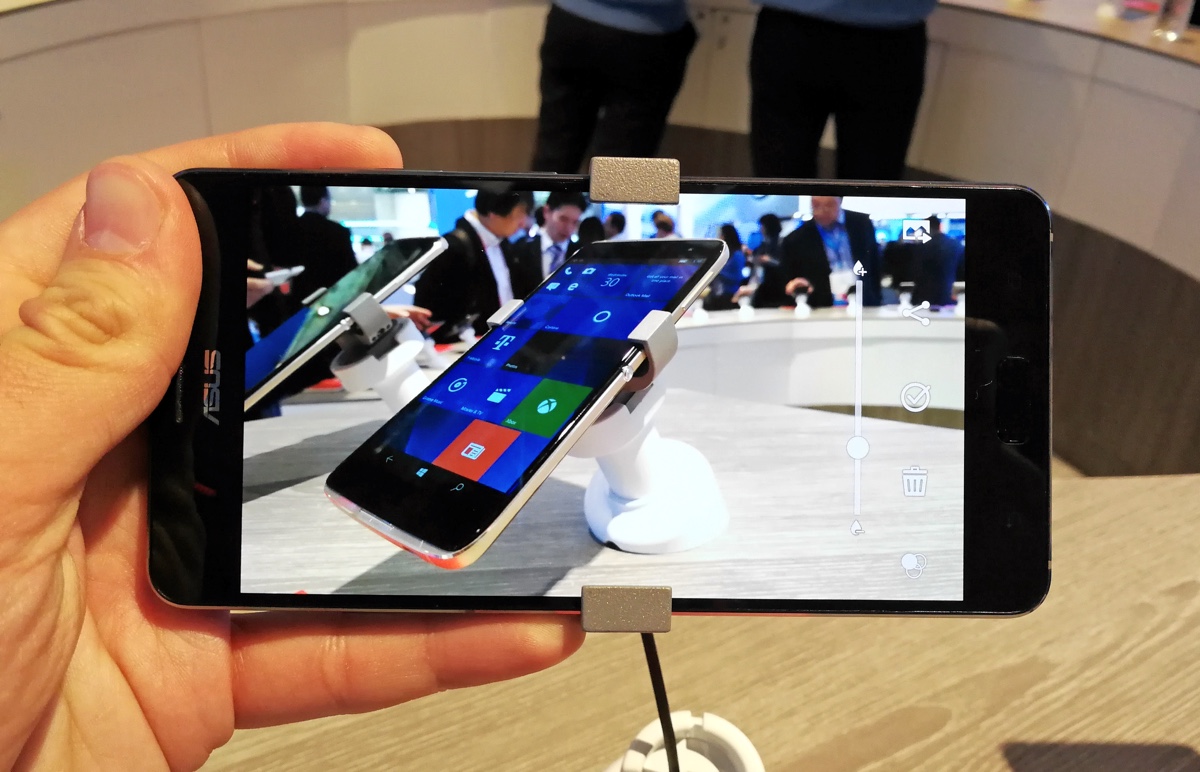
IPS models also cannot be inferior in quality and have a number of their positive aspects:
- The screen has a high resolution.
- Electricity consumption is at a very low level.
- The transmitted colors in the pictures are as close as possible to the real ones.
- The screen has excellent contrast, and the brightness is also at a good level.
- Pictures are obtained on such a phone clear and accurate. Keep a grid of subpixels in such phone models cannot be seen with the naked eye. This is one of the reasons for such a good image transmission.

But it cannot be said that models of such phones do not have drawbacks.
All users who have encountered a similar model note that the phones react to clicks for a long time. It does not bring much discomfort, but I would like better.
Naturally, when presenting phones whose displays are made according to this method, one cannot give a one hundred percent guarantee for all the presented models. After all, they all contain different types matrices.
But the screens that are made using super amoled technology are all similar to each other and the quality is about the same in all.
That is, there is an obvious difference between these two models. And bright color reproduction, and the thickness of the screen, which surpasses the technology of amoled.
But if you need natural colors, for example when photographing, then ips will provide them to you.
According to all of the above, the leader can be called super amoled screens, which manufacturers are happy to put on tablets and smartphones.
They have a sufficiently high sensitivity, which, in turn, allows the device to respond to commands much faster.
Conclusion
And so, you are in front huge selection and trying to decide on the model that you will use in the next couple of years.
The very first thing you need to pay attention to when making an important decision is what you will use the device for.
If you need pictures in which all colors are correctly transmitted, then it is better to stop at ips.
If such a moment is not important for you, but at the same time you want the battery not to discharge at a tremendous speed. Stop at amoled displays. The picture in this phone will look richer.
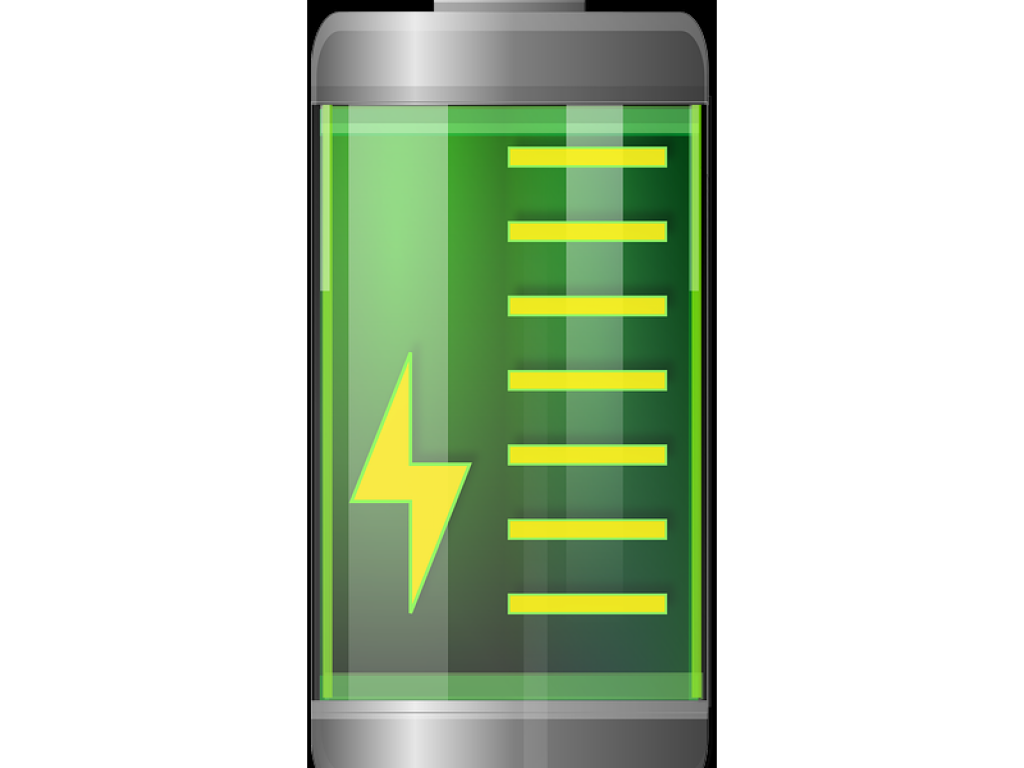
If we compare phones, many differences could not be obtained during visual inspection. And the technologies by which each of them are made are not those in which everyone should understand.
That is, when choosing for personal use, you need not spare money, but choose exactly those offers that have fallen to your soul.
If there are no plans to change the device every year, you should still stop at ips.
After all, a burnt-out screen on another model under consideration will not allow you to work normally with it. Although there are times when such burnout is almost imperceptible.
Instruction: Manufacturing companies are tacitly fighting for supremacy in the world of the IT industry and ordinary users in this competition are judges.
Re-reading this article and having considered both variants of phone screens, each user will be able to individually decide what exactly he likes.
Each technology has its positive and negative qualities. They are outlined above.
I advise you to watch the video, it will help you to more specifically understand both models and draw the right conclusions regarding each of them.
At the moment, global manufacturers have begun to produce a smartphone with an IPS screen, which significantly exceeds the capabilities of conventional displays in terms of its parameters. So, among the main characteristics of this element, it should be noted:
- Excellent reproduction of the entire existing spectrum of colors. Now the consumer will be able to see an image that maximally conveys the smallest features of the texture of the object.
- The matrix is very resistant to physical or mechanical influences. If ordinary displays begin to distort the image when pressed, then such deformations do not threaten these screens.
- The quality of the picture, which is unable to create problems with vision, regardless of the time of constant use of the phone. This characteristic has been verified with the help of special tests by highly qualified ophthalmologists.
- Fairly wide viewing angles. Now the consumer has the opportunity to watch their favorite programs or play games even in public transport, without feeling the slightest inconvenience. The viewing angle is equal to 178 degrees vertically and horizontally.
- The response takes a very small amount of time, despite the well-established stereotype about the low performance of such devices. Choosing a smartphone with an IPS screen means purchasing a high-quality product that is ready to optimally fulfill any requirements of its immediate owner.
- The ability to watch videos and play games in maximum quality. Together with this display, phone models are often equipped with a high-frequency processor that can guarantee the maximum speed of all device processes.
These excellent apparatuses do not currently cost much. So, for a smartphone with an IPS screen, the price is consistently calculated for all average citizens of the state. The acquisition of such a masterpiece of technology is also quite simple, since numerous stores already work directly with manufacturers' branches. The consumer needs to decide on the model he likes and the company that developed it, and then place an order via the Internet or personally visit the place of sale. These devices can radically change the standard of human life, give him the opportunity to relax, no matter where he is.
